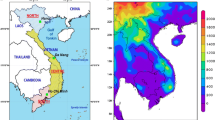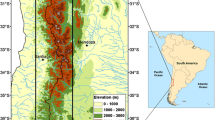Abstract
A high-resolution climate model simulation has been performed for the first time for Fiji’s climatology. The simulation involved a numerical experiment for a 10-year period (1975–1984), and was conducted at a horizontal resolution of 8 km in a stretched-grid configuration, which is currently the highest resolution at which a global climate model has been applied for regional climatological simulations. Analysis of model-generated data demonstrates a fairly good skill of the CSIRO Conformal-Cubic Atmospheric Model (C-CAM) in the simulation of the annual cycles of maximum and minimum temperatures and rainfall at selected locations in Fiji. The model has also successfully reproduced the pattern of maximum and minimum surface air temperatures between the western and central divisions of Fiji. Model simulation of spatial and temporal distribution of monthly total rainfall (10-year mean) over the main island of Viti Levu in Fiji shows that it reproduces the observed intraseasonal and interannual variability; the influence of the El Niño phenomena has also been captured well in the model-simulated rainfall.










Similar content being viewed by others
References
Chouinard C, Béland M, McFarlane N (1986) A simple gravity wave drag parameterization for use in medium range weather forecast models. Atmos-Ocean 24:91–110
Déqué M, Piedelievre JP (1995) High resolution climate simulation over Europe. Clim Dyn 11:321–339
Fels SB, Schwarzkopf MD (1975) The simplified exchange approximation: a new method for radiative transfer calculations. J Atmos Sci 32:1475–1488
Folland CK, Renwick JA, Salinger MJ, Mullan AB (2002) Relative influences of the Interdecadal Pacific Oscillation and ENSO on the South Pacific Convergence Zone. Geophys Res Lett 29(13):1–4
Fox-Rabinovitz M, Côté J, Dugas B, Déqué M, McGregor JL (2006) Variable resolution general circulation models: stretched-grid model intercomparison project (SGMIP). J Geophys Res 111:D16104. doi:10.1029/2005JD006520
Giorgi F, Francisco R (2000) Evaluating uncertainties in the prediction of regional climate change. Geophys Res Lett 27:1295–1298
Giorgi F, Mearns LO (1991) Approaches to regional climate change simulation: a review. Rev Geophys 29:191–216
Holtslag AAM, Boville BA (1993) Local versus non-local boundary layer diffusion in a global climate model. J Clim 6:1825–1842
Jones RG, Murphy JM, Noguer M (1995) Simulation of climate change over Europe using a nested regional climate model. I: Assessment of control climate including sensitivity to location of lateral boundaries. Q J R Meteorol Soc 121:1413–1449
Kalnay E, Kanamitsu M, Kistler R, Collins W, Deaven D, Gandin L, Iredell M, Saha S, White G, Woollen J, Zhu Y, Chelliah M, Ebisuzaki W, Higgins W, Janowiak J, Mo KC, Ropelewski C, Wang J, Leetmaa A, Reynolds R, Jenne R, Joseph D (1996) The NCEP/NCAR 40-year reanalysis project. Bull Amer Meteorol Soc 77:437–472
Kowalczyk EA, Garratt JR, Krummel PB (1994) Implementation of a soil-canopy scheme into the CSIRO GCM—regional aspects of the model response. CSIRO Div Atmospheric Res Tech Paper No 32:59
Mataki M, Koshy K, Lal M (2006) Baseline climatology of Viti Levu (Fiji) and current climatic trends. Pacific Sci 60(1):49–68
McGregor JL (1993) Economical determination of departure points for semi-Lagrangian models. Mon Weather Rev 121:221–230
McGregor JL (1996) Semi-Lagrangian advection on conformal-cubic grids. Mon Weather Rev 124:1311–1322
McGregor JL (1997) Regional climate modelling. Meteorol Atmos Phys 63:105–117
McGregor JL (2003) A new convection scheme using a simple closure. In “Current issues in the parameterization of convection”. BMRC Res Report 93:33–36
McGregor JL (2005a) C-CAM: geometric aspects and dynamical formulation [electronic publication]. CSIRO Atmos Res Tech Paper No 70:42
McGregor JL (2005b) Geostrophic adjustment for reversibly staggered grids. Mon Weather Rev 133:1119–1128
McGregor JL, Dix MR (2001) The CSIRO conformal-cubic atmospheric GCM. In: Hodnett PF (ed) IUTAM Symposium on advances in mathematical modelling of atmosphere and ocean dynamics. Kluwer, Dordrecht, pp 197–202
McGregor JL, Walsh KJ, Katzfey J (1993a) Nested modelling for regional climate studies. In: Jakeman AJ, Beck MB, McAleer MJ (eds) Modeling change in environmental systems. Wiley, New York, pp 367–386
McGregor JL, Gordon HB, Watterson IG, Dix MR, Rotstayn LD (1993b) The CSIRO 9-level atmospheric general circulation model. CSIRO Atmos Res Tech Paper No 26:89
McGregor JL, Nguyen KC, Katzfey JJ (2002) Regional climate simulations using a stretched-grid global model. In: Ritchie H (ed) Research Activities in Atmospheric and Oceanic Modelling Report No. 32, WMO/TD-No. 1105, pp 3.15–3.16
Rancic M, Purser RJ, Mesinger F (1996) A global shallow water model using an expanded spherical cube: genomonic versus conformal coordinates. Q J R Meteorol Soc 122:959–982
Rivest CA, Staniforth A, Robert A (1994) Spurious resonant response of semi-Lagrangian discretizations to orographic forcings: diagnosis and solution. Mon Weather Rev 122:366–376
Rotstayn LD (1997) A physically based scheme for the treatment of stratiform clouds and precipitation in large-scale models. I: Description and evaluation of the microphysical processes. Q J R Meteorol Soc 123:1227–1282
Schmidt F (1977) Variable fine mesh in spectral global model. Beitr Phys Atmos 50:211–217
Schwarzkopf MD, Fels SB (1991) The simplified exchange method revisited: an accurate rapid method for computation of infrared cooling rates and fluxes. J Geophys Res 96:9075–9096
Smith RNB (1990) A scheme for predicting layer clouds and their water content in a general circulation model. Q J R Meteorol Soc 116:435–460
Thuburn J (1993) Use of a flux-limited scheme for vertical advection in a GCM. Q J R Meteorol Soc 119:469–487
von Storch H, Langenberg H, Feser F (2000) A spectral nudging technique for dynamical downscaling purposes. Mon Weather Rev 128:3664–3673
Author information
Authors and Affiliations
Corresponding author
Rights and permissions
About this article
Cite this article
Lal, M., McGregor, J.L. & Nguyen, K.C. Very high-resolution climate simulation over Fiji using a global variable-resolution model. Clim Dyn 30, 293–305 (2008). https://doi.org/10.1007/s00382-007-0287-0
Received:
Accepted:
Published:
Issue Date:
DOI: https://doi.org/10.1007/s00382-007-0287-0




